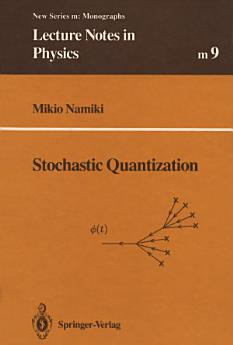Stochastic Quantization
ຕ.ລ. 2008 · Lecture Notes in Physics Monographs ຫົວທີ 9 · Springer Science & Business Media
ປຶ້ມອີບຸກ
217
ໜ້າ
reportບໍ່ໄດ້ຢັ້ງຢືນການຈັດອັນດັບ ແລະ ຄຳຕິຊົມ ສຶກສາເພີ່ມເຕີມ
ກ່ຽວກັບປຶ້ມ e-book ນີ້
This is a textbook on stochastic quantization which was originally proposed by G. Parisi and Y. S. Wu in 1981 and then developed by many workers. I assume that the reader has finished a standard course in quantum field theory. The Parisi-Wu stochastic quantization method gives quantum mechanics as the thermal-equilibrium limit of a hypothetical stochastic process with respect to some fictitious time other than ordinary time. We can consider this to be a third method of quantization; remarkably different from the conventional theories, i. e, the canonical and path-integral ones. Over the past ten years, we have seen the technical merits of this method in quantizing gauge fields and in performing large numerical simulations, which have never been obtained by the other methods. I believe that the stochastic quantization method has the potential to extend the territory of quantum mechanics and of quantum field theory. However, I should remark that stochastic quantization is still under development through many mathematical improvements and physical applications, and also that the fictitious time of the theory is only a mathematical tool, for which we do not yet know its origin in the physical background. For these reasons, in this book, I attempt to describe its theoretical formulation in detail as well as practical achievements.
ໃຫ້ຄະແນນ e-book ນີ້
ບອກພວກເຮົາວ່າທ່ານຄິດແນວໃດ.
ອ່ານຂໍ້ມູນຂ່າວສານ
ສະມາດໂຟນ ແລະ ແທັບເລັດ
ຕິດຕັ້ງ ແອັບ Google Play Books ສຳລັບ Android ແລະ iPad/iPhone. ມັນຊິ້ງຂໍ້ມູນໂດຍອັດຕະໂນມັດກັບບັນຊີຂອງທ່ານ ແລະ ອະນຸຍາດໃຫ້ທ່ານອ່ານທາງອອນລາຍ ຫຼື ແບບອອບລາຍໄດ້ ບໍ່ວ່າທ່ານຈະຢູ່ໃສ.
ແລັບທັອບ ແລະ ຄອມພິວເຕີ
ທ່ານສາມາດຟັງປຶ້ມສຽງທີ່ຊື້ໃນ Google Play ໂດຍໃຊ້ໂປຣແກຣມທ່ອງເວັບຂອງຄອມພິວເຕີຂອງທ່ານໄດ້.
eReaders ແລະອຸປະກອນອື່ນໆ
ເພື່ອອ່ານໃນອຸປະກອນ e-ink ເຊັ່ນ: Kobo eReader, ທ່ານຈຳເປັນຕ້ອງດາວໂຫຼດໄຟລ໌ ແລະ ໂອນຍ້າຍມັນໄປໃສ່ອຸປະກອນຂອງທ່ານກ່ອນ. ປະຕິບັດຕາມຄຳແນະນຳລະອຽດຂອງ ສູນຊ່ວຍເຫຼືອ ເພື່ອໂອນຍ້າຍໄຟລ໌ໄໃສ່ eReader ທີ່ຮອງຮັບ.







